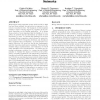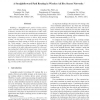468 search results - page 79 / 94 » Energy Model for H2S Monitoring Wireless Sensor Network |
SENSYS
2003
ACM
14 years 23 days ago
2003
ACM
Event-driven sensor networks operate under an idle or light load and then suddenly become active in response to a detected or monitored event. The transport of event impulses is l...
ICDCSW
2009
IEEE
14 years 2 months ago
2009
IEEE
Building a “Straightforward” path in wireless ad hoc sensor networks (WASNs) not only avoids wasting energy in detours, but also incurs less interference in other transmission...
MSN
2007
Springer
14 years 1 months ago
2007
Springer
There are many applications of large scale sensor networks in which both the stimulus and the data collection stations are mobile (i.e. animal tracking, battlefield chasing). TTDD ...
ICC
2009
IEEE
14 years 2 months ago
2009
IEEE
—The use of variable data rate can reduce network latency and average power consumption, and automatic rate selection is critical for improving scalability and minimizing network...
AAAI
2007
13 years 9 months ago
2007
In many sensing applications we must continuously gather information to provide a good estimate of the state of the environment at every point in time. A robot may tour an environ...


